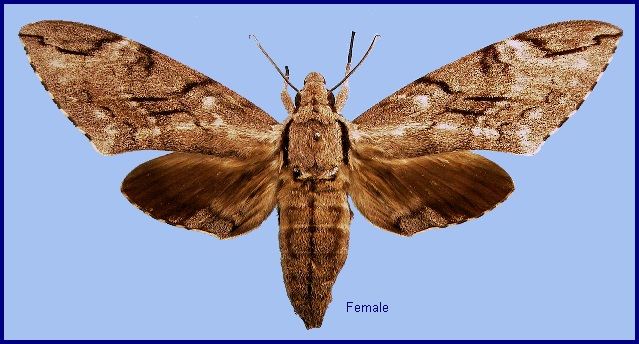
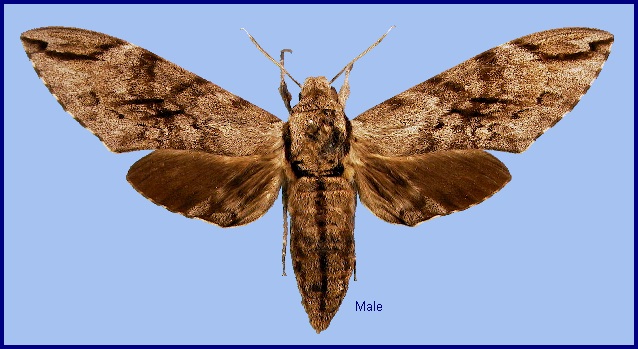
Anceryx increta Walker, [1865], List of the Specimens of Lepidopterous Insects in the Collection of the British Museum. 31: 36. Type locality: [China,] Shanghai.
Synonym. Anceryx increta Walker, [1865].
Synonym. Sphinx strobi Boisduval, 1868.
Synonym. Sphinx abietina Boisduval, 1875.
Synonym. Psilogramma increta serrata Austaut, 1912.
Synonym. Psilogramma increta f. montana (Mell, 1922).
Synonym. Psilogramma andamanica Brechlin, 2001.
Synonym. Psilogramma japonica Eitschberger, 2001.
Synonym. Psilogramma lukhtanovi Eitschberger, 2001.
Synonym. Psilogramma mandarina Eitschberger, 2001.
Synonym. Psilogramma monastyrskii Eitschberger, 2001.
Synonym. Psilogramma reinhardti Eitschberger, 2001.
Synonym. Psilogramma yilingae Eitschberger, 2001.
Note. A male has been labelled as manuscript lectotype in the NHMUK (M. R. Honey, pers. comm.). A neotype was incorrectly and unnecessarily designated by Eitschberger, 2001 (May 14), Neue ent. Nachr. (Suppl. 1): 4.
Note. Synonymized with Pseudosphinx discistriga (Walker, 1856) by Hampson, [1893], Fauna Brit. India 1: 105. Reinstated as a species by Bartel, 1899, in Rühl & Bartel, 1899-1902, Die palaearktischen Grossschmett. Naturgesch. 2: 37 (key), 51. Synonymized with Psilogramma menephron as a subspecies by Rothschild & Jordan, 1903, Novit. zool. 9 (suppl.): 45. Reinstated as a species by Mell, 1922, Beitr. Fauna Sinica 2 (Biol. Syst. südchin. Sphingiden): 38.
[Further details on this species in Japan, as well as photos of many stages, can be found on Digital Moths of Japan as well as Moths of the southern Shikoku, Japan.]
Wingspan: 90--122mm. Forewing upperside uniform grey in the pale form, with the transverse lines poorly defined; a black oblique bar at the apex of the discal cell; the apical lines, the costal part of the discal lines, and two discal streaks all very conspicuous against the pale background. In the dark form, all black markings heavier on the forewing upperside, and with a conspicuous black medio-costal area; apical area darker. The underside of the abdomen is usually pure white in this species and brownish in the very similar Psilogramma discistriga (Walker, 1856). Males can make a weak hissing sound by rubbing scales over spines at the end of the abdomen.
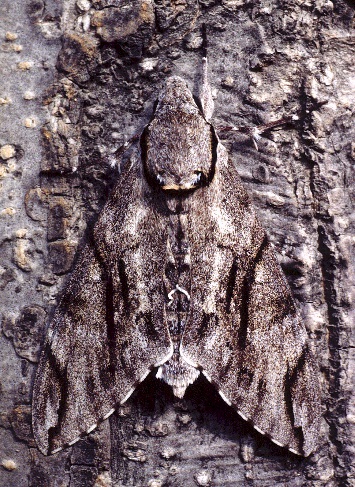
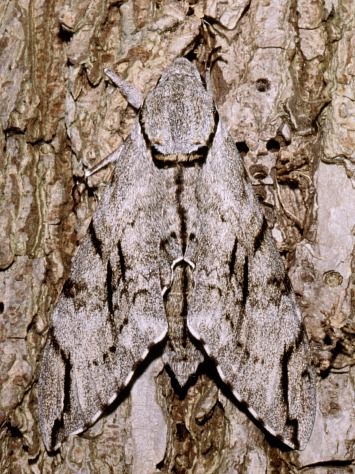
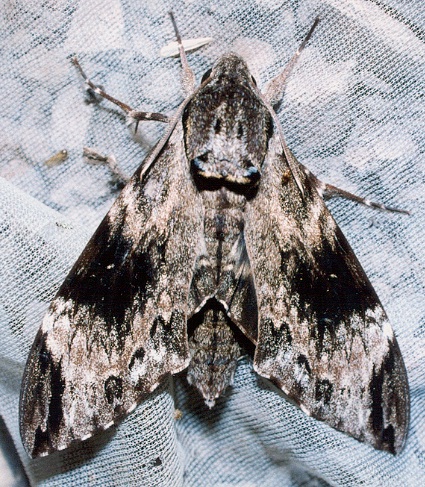
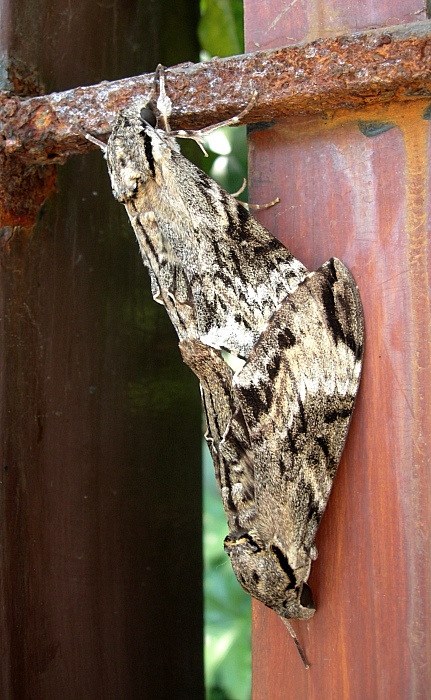
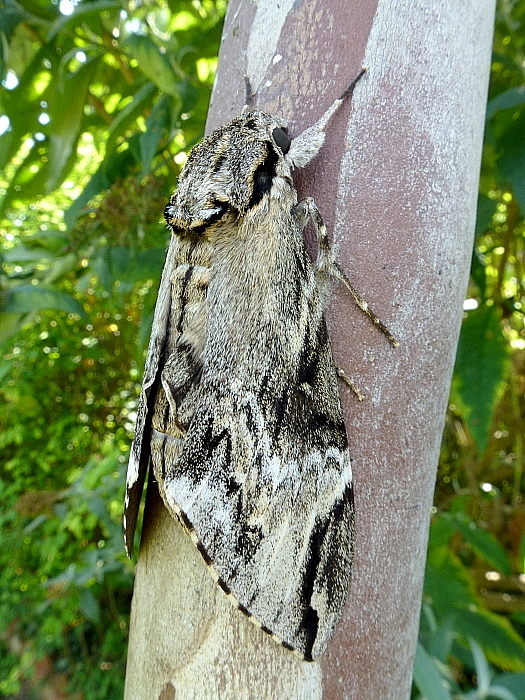
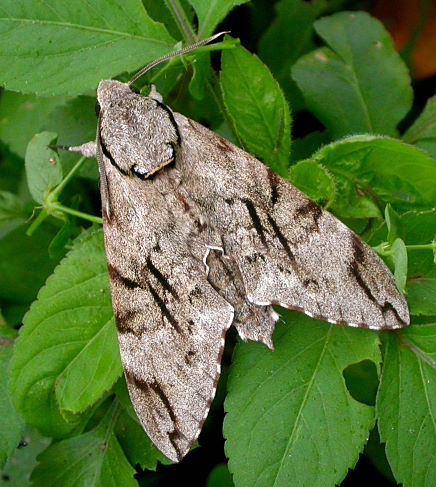
A species of open parkland, city suburbs and forest edge.
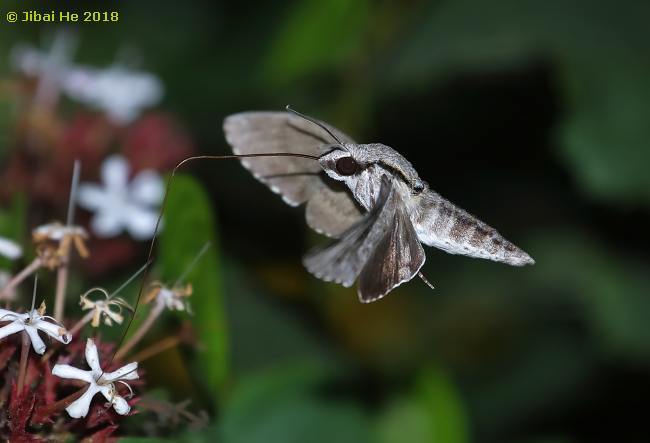
China: v-vii (Sichuan); 17.v. (Zhejiang); 19.v (Shanghai); vi (Yunnan; Hainan; Guizhou; Jiangxi; Beijing); 30.vi (Zhejiang); vii (Liaoning; Shanghai); 20.vii (Shaanxi); viii (Hubei; Guangxi); 25.viii-19.ix (Shanghai); ix (Shaanxi); 18-21.ix-x (Hong Kong). Taiwan: vii-ix (Pingtung Hsien). North Korea: vi (Mt. Kuwol). South Korea: 6.vii (unstated locality). Japan: 27.v-21.vi (Ryukyu Archipelago); 12.vi-7.viii (Honshu; Tsushima); 20.vii (Hokkaido); 9.viii-27.viii (Hokkaido); 17.viii-26.x (Honshu); 18.viii (Shikoku). Russia: 1-7.viii (Primorskiy Krai).
In northern China there are two generations per year, with adults flying in April-May and August-September (Yang, 1978).
Kendrick (2002) states that it is multivoltine in Hong Kong, occurring from March until late November in up to five generations.
Park et al. (1999) give early June until late August as the flight period in Korea.
OVUM: Pale, transluscent green when laid, becoming more opaque and yellowish as it develops.
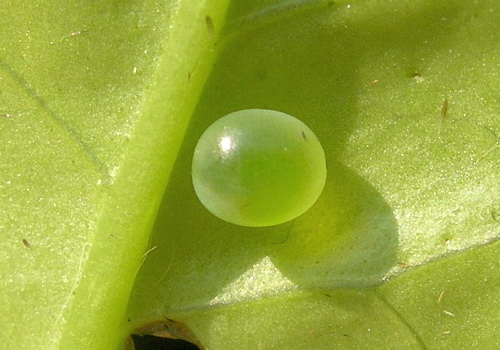
LARVA: Full-fed 69--110mm. Pale yellow on hatching, with a large black horn. With feeding the body colour becomes more green. At this stage most growth is in length, not width.
Generally a tree-feeding species, resting under the leaves on the lower branches of large-leaved trees, but along the twigs of terminal shoots if the tree is smaller leaved. Usually within 0.5-4m of the ground.
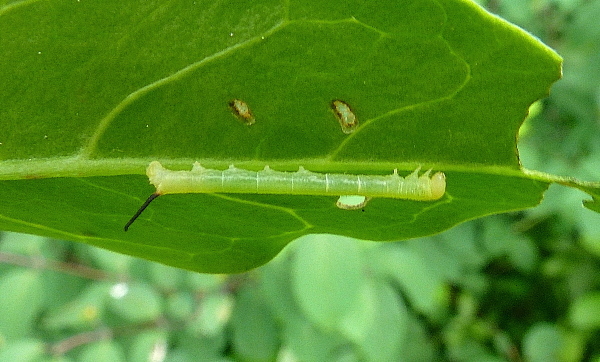
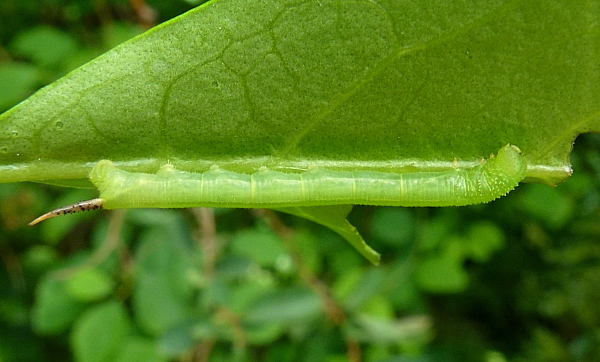
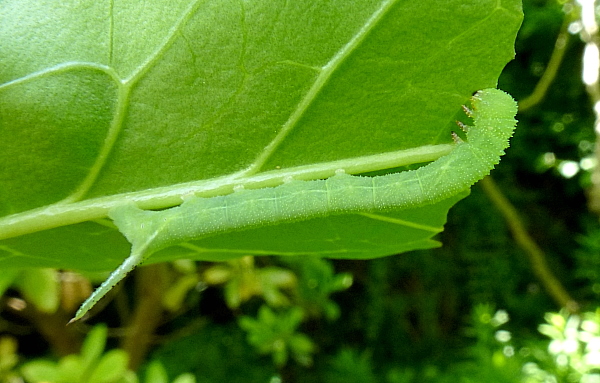
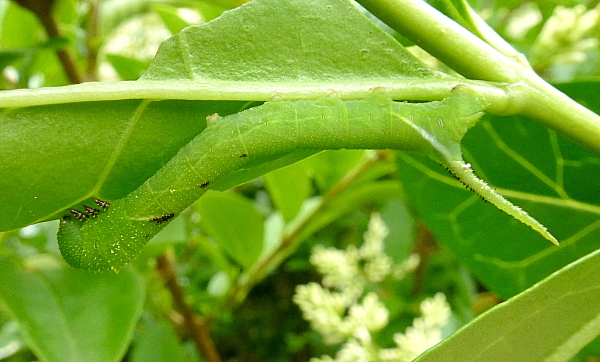
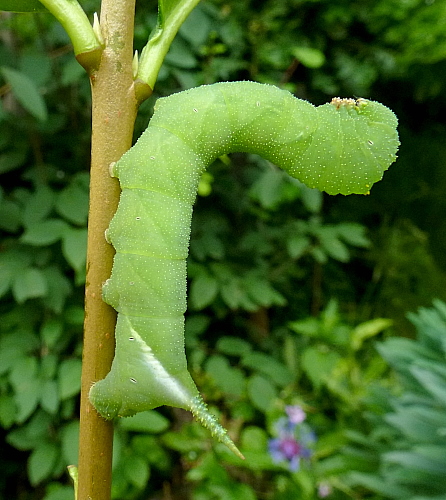
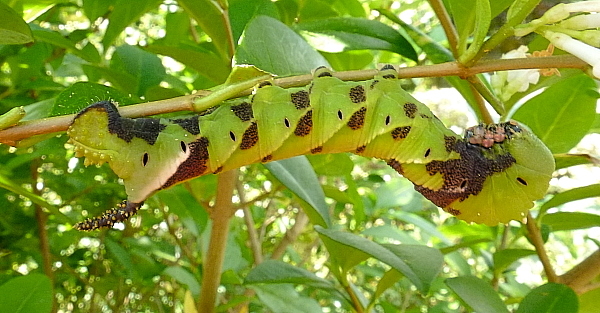
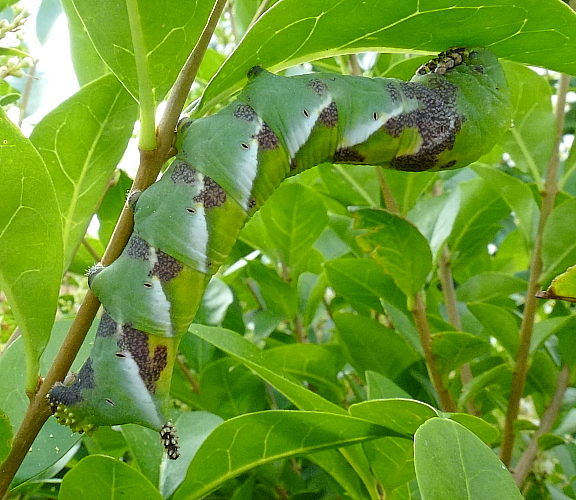
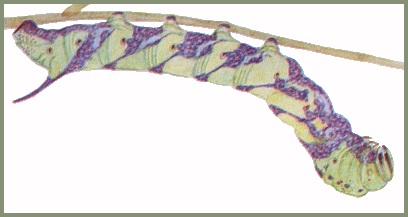
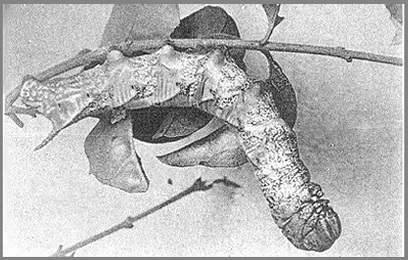
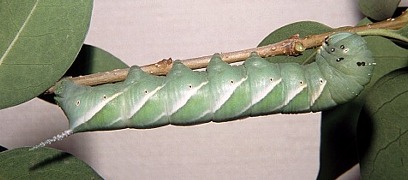
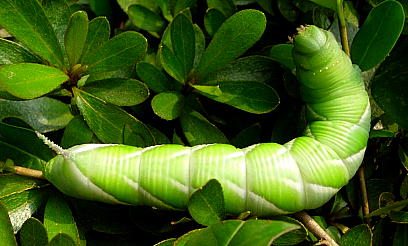
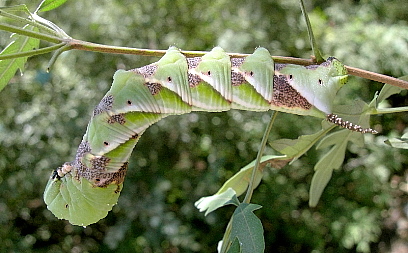
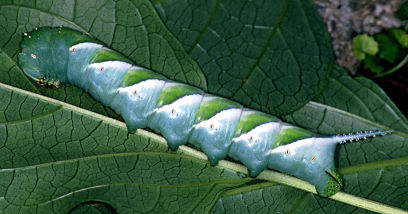
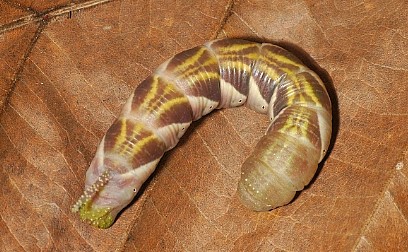
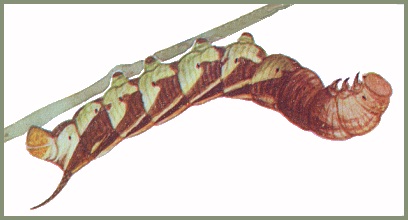
PUPA: 45--56mm. Reddish mahogany brown and glossy, but with a pronounced grey bloom at first; this rapidly wears off. Head projecting frontad, with a pronounced free tongue-case stretching one third the way down the wing cases. This has a bulbous tip. Wings smooth, abdominal segments mainly smooth but finely punctate around the leading edge. Spiracular ridges present on movable abdominal segments. Cremaster broadly triangular, dorso-ventrally flattened, with a double sharp point; tuberculate. Similar to that of Agrius convolvuli, but free tongue-case shorter and not reflexed. Formed in an almost silk-free cell in the soil. The overwintering stage.
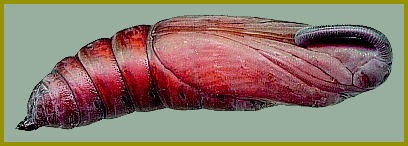
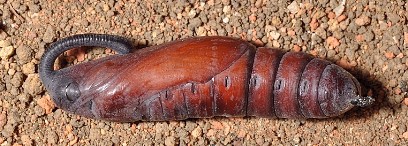
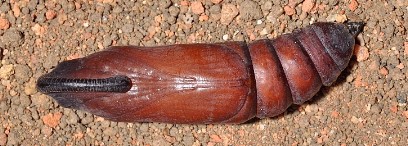
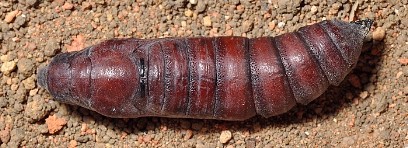
Larval hostplants. Recorded in China on Campsis (as Tecoma), Catalpa, Clerodendrum, Dimocarpus, Firmiana, Fraxinus, Jasminum, Ligustrum, Melia, Meliosma, Olea, Osmanthus, Paulownia, Syringa and Vitex (Mell, 1922b; Yang, 1978; Chu et al., 1979; Wang, 1992; Cheng & Yan, 2011), although some records may correctly refer to Psilogramma discistriga. The record on Platanus (Wang, 1992) is suspect. In 1995, the first author found larvae on Ligustrum lucidum in Anhui, and Li & Guo (1990) give Syringa for Shanxi. Kendrick (2002) gives Vitex negundo as the main hostplant in Hong Kong. In September 2018 a full-grown larva was also found on Lonicera maackii (Rupr.) Maxim. in the Haidian District of Beijing, China (Vyacheslav Ivonin & Yanina Ivonina, pers. comm. 2022).
In Taiwan, recorded from Callicarpa formosana, Chionanthus retusus, Clerodendrum canescens, Clerodendrum cyrtophyllum, Clerodendrum japonicum [syn. Clerodendrum kaempferi (Jacq.) Siebold ex Hassk.], Clerodendrum paniculatum, Clerodendrum quadriloculare, Clerodendrum trichotomum, Fraxinus griffithii, Fraxinus pennsylvanica, Handroanthus chrysotrichus [syn. Tecoma grandis], Jasminum sambac, Ligustrum liukiuense, Ligustrum sinense, Odontonema tubaeforme [syn. Odontonema strictum], Osmanthus fragrans, Paulownia fortunei, Radermachera sinica, Sesamum indicum, Spathodea campanulata, Tecoma stans, Vitex negundo var. cannabifolia, Vitex quinata, Vitex trifolia subsp. litoralis [syn. Vitex rotundifolia] and Volkameria inermis [syn. Clerodendrum inerme].
Recorded in Korea on Ligustrum obtusifolium, Ligustrum japonicum, Syringa reticulata, Syringa dilatata, Osmanthus fragrans, Clerodendrum tricotonum, Paulownia tomentosa, Paulownia coreana and Quercus aliena (Park et al., 1999).
In Japan, recorded from Callicarpa dichotoma, Ligustrum japonicum, Ligustrum obtusifolium, Paulownia tomentosa, Perilla frutescens, Sesamum indicum and Viburnum dilatatum.
In Thailand on Oroxylum indicum, Radermachera sinica, Millingtonia hortensis, Spathodea campanulata, Handroanthus chrysotrichus and Dolichandrone serrulata (Namee, 2017; Küppers & Janikorn, 2019).
Elsewhere, larval hostplants are mostly from Oleaceae, Scrophulariaceae and Verbenaceae, with occasional records from a number of other families.
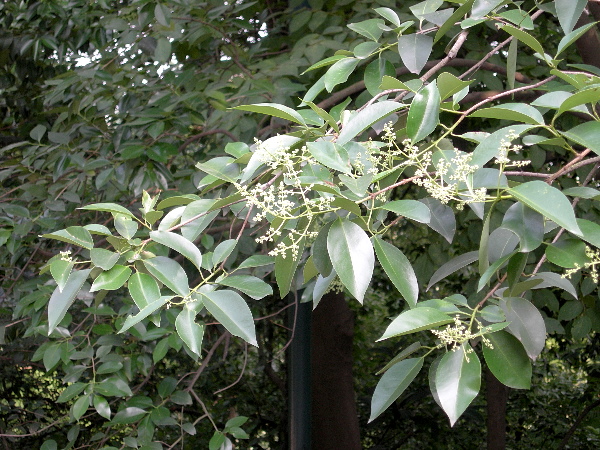
Ichneumonidae: Quandrus pepsoides (Smith, 1852); Tachinidae: Drino (Zygobothria) atropivora (Robineau-Desvoidy, 1830).
China: Heilongjiang (Harbin); Liaoning (Dalian); Hebei (Chengde); Beijing (Haidian; Xiangshan; Baihua Shan; Badaling National Forest Park); Shandong (Qingdao); Shanxi (Xiaxian); Shaanxi (Yangling; Daiwang Shan, 1380m; Tongchuan); Henan; Anhui (Hefei); Shanghai; Zhejiang (Hangzhou; Ningbo; Siming Shan); Hubei (Yichang; Lichuan; Wuhan); Sichuan (Chengdu; Emei Shan); Yunnan (nr. Jinping, 2155m; Simao/Pu'er; Gaoligong Shan); Guizhou (Fanjingshan, Tongren County); Hunan (Dayong); Jiangxi (Le'an); Fujian; Guangdong (Guangzhou); Hong Kong; Guangxi (Liuzhou); Hainan (Duowen Ling, nr Lingao; Longhushan, Wenchang City).
Taiwan: Taitung; Taichung (Kukuan); Taipei Hsien (Wulai); Taipei (Yangmingshan; Sindian); Nantou Hsien (Jenai; Puli; Lushan Spa); Kaohsiung Hsien (Shanping; Chishan); Hualien Hsien (Hungyeh); Tainan (Anping); Pingtung Hsien (Kenting; Sheting); Orchid Island/Botel Tobago.
North Korea: South Hwanghae Province (Mt. Kuwol, 950m); Kangwon Province (Keumgang-san); North Hamgyong Province (Gyungsung); South Pyongan Province (Pyongyang).
South Korea: Seoul (Seoul; Nan-san); Kyonggi Province (Suwon; Gwangleung; Cheonma-san; Asan Bay; Myungji-san); Kangwon Province (Cheolwon; Hwacheon; Gojindong; Geonbong Temple; Seolak-san; Gangleung; Woljeong Temple; Sogumgang; Chiak-san; Hoengseong-dam; Donghae; Chuncheon; Bongmyung-ri; Odae-san; Hongcheon; Youngwol); North Chungchong Province (Songni-san; Chupungryung; Minjuji-san); South Chungchong Province (Gongju; Gyeryong-san); North Cholla Province (Jiri-san; Namwon; Muju); South Cholla Province (Baekyang Temple; MokpoJogye-san; Jin-do; Geumo-do; Yeon-do; Hong-do; Gurye; Yeocheon); North Kyongsang Province (Daegu; Sobaek-san; Juwang-san; Ulleung-do); South Kyongsang Province (Gibaek-san; Hwangsuk-san; Hamyang; Jinyang; Pusan; Jinju; Geoje-do; Goseong; Manhae; Sancheong; Hadong; Hapcheon); Cheju Province (Cheju-do; Halla-san; Seoguipo; Ora-dong; Ara-dong; Topyung; Susan-ri; Suakbong; Gwaneum Temple).
Japan: Hokkaido (Matsumae; Nanae, Kameda District); Honshu (Gifu; Yokohama; Nashimoto; Shinshiro; Mikaboyama, 750m; Fujisawa; Bushi; Hachijyo Island; Oki Islands); Shikoku (Ochi); Kyushu (Kagoshima; Naze); Tsushima (Sasuna); Ryukyu Archipelago (Amamio-jima; Okinawa (Manabe et al., 2014); Iriomote-jima; Tanega-jima; Yaku-jima).
Russia: Primorskiy Krai (Andreevka Village; 10 km NW of Barabash). A very recent (2020-2022) colonist of this region (Spitsyn & Spitsyna, 2021; Makhov, Lukhtanov & Matov, 2024).
This species occurs from northern Pakistan (Rafi et al., 2014) and northwestern India eastwards across Nepal, Bhutan (Irungbam & Irungbam, 2019) and Burma/Myanmar to Thailand, Laos and Vietnam (Le & Vu, 2024), then north through Taiwan and eastern China to Korea, Japan (Komatsu & Inoko, 2000), and east to Hawaii. Found for the first time in the southern part of Primorskiy Krai, Russian Far East, in August 2020 (Spitsyn & Spitsyna, 2021), and then again in 2022 (Makhov, Lukhtanov & Matov, 2024).
[Psilogramma increta is replaced in the Western Ghats, southern India, and Sri Lanka by Psilogramma vates (Butler, 1875); in Peninsular Malaysia and the Greater Sunda Islands, Indonesia, by Psilogramma edii (Eitschberger, 2001), and by other species in the other islands of Indonesia and farther east. However, the status of many of these species, which are mostly based on minor and often inconsistent differences in wing pattern and genital morphology, remain to be critically assessed.]
The introduced populations on Guam and Hawaii have now been confirmed as being Psilogramma increta, not Psilogramma menephron -- Psilogramma discistriga (Walker, 1856) as originally suspected (Austin & Rubinoff, 2022). It's colonization of Hawaii seems to have started in 1976-77 (Riotte, 1986).
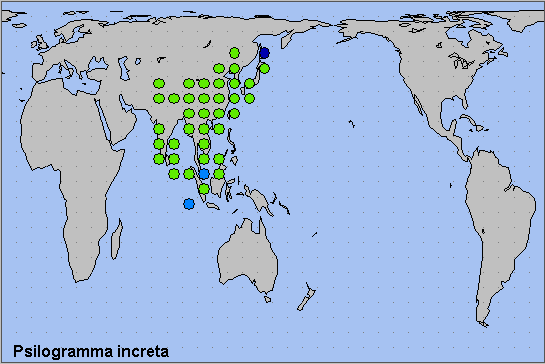
Holarctic and Oriental; eastern Palaearctic region. Pleistocene refuge: Unknown.
 Return to Sphingidae of the Eastern Palaearctic species list
Return to Sphingidae of the Eastern Palaearctic species list